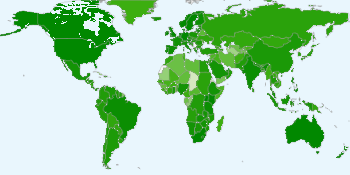The partnership between Chad and Cameroon produces results; DRC faces broadband challenges.
Chad
Last week, Chad celebrated its connection to the SAT3 cable through Cameroon with three ceremonies. One, held in Chad, spoke to the need to reduce the digital divide. Another ceremony held in Cameroon, consisted of a video conference between Chadian President Idris Deby and his ambassador in Cameroon. Finally, the President demonstrated the international capabilities by Skyping through France. The project is the first milestone of the Central Africa Backbone which plans on filling a void in terrestrial connectivity in nations like Chad, Cameroon, and Central African Republic.
 Per traffic map for the recent Kony 2012 video, Chad (and Western Sahara) severely lag in broadband capacity. {YouTube}
Per traffic map for the recent Kony 2012 video, Chad (and Western Sahara) severely lag in broadband capacity. {YouTube}
Democratic Republic of Congo
Source: Fibre optique: la maffia bloque (Fiber optic: the mafia blocks it) {Digitalcongo.net}
After the WACS cable landed in Muanda in February 2011, the cable promised to be operational by the end of 2011. Since then, the country has dragged its feet. Apparently the project(s) will start and stop without much notice. That much is true to create a link to Kinshasa. Although, the author of this recent article blames the delays in projects on the mafia. Instead, delays seem to sprout from ineffective relationships between the Congolese Society of Post and Telecommunications (SCPT) and those responsible for public procurement of funds. Part of the problem has been the collapse of the incumbent Office Conolais des Postes et Telecommunications (OCPT). In essence, the government, overwhelmed with political problems, is less-than-effective in providing broadband. The private sector is more skilled, but gets blocked by government red tape.
![]()






































